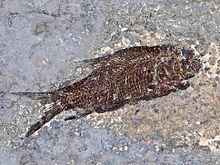Loading AI tools
Extinct genus of fishes From Wikipedia, the free encyclopedia
Jianghanichthys is an extinct genus of freshwater cypriniform fish from the Late Paleocene to Early Eocene of central and southern China, and the only member of the family Jianghanichthyidae.[1] It is the oldest cypriniform fish known from body fossils, and the most basal known cypriniform.[2][3]
| Jianghanichthys Temporal range: | |
|---|---|
 | |
| Fossil of J. hubeiensis from China | |
| Scientific classification | |
| Domain: | Eukaryota |
| Kingdom: | Animalia |
| Phylum: | Chordata |
| Class: | Actinopterygii |
| Order: | Cypriniformes |
| Family: | †Jianghanichthyidae Liu, Chang, Wilson & Murray, 2015 |
| Genus: | †Jianghanichthys Lei, 1987 |
| Type species | |
| †Osteochilus hubeiensis Lei, 1977 | |
| Species | |
| |
The genus name Jianghanichthys derives from "Jianghan", the place where the first fossil remains of J. hubeiensis were found, and "ichthys" derives from the Greek word for 'fish'.[1] It is also known as the "Chan Han fish" in the fossil trade.[4]
Two species are known, both of which were previously placed in Osteochilus:
There are still disagreements as to the scientific classification, name and age of this genus. However the body shape of Jianghanichthys differs from that of all Amyzon species. J. hubeiensis was reclassified from Osteochilus into the new genus Jianghanichthys in 1987, and in 2015 it was moved from the Catostomidae to the new, basal family Jianghanichthyidae.[1] In 2024, the slightly older species J. sanshuiensis was also reclassified into this genus from Osteochilus, marking both a slight temporal extension and a range extension for the genus.[3]

These fishes lived in the early Paleogene period. Fossils of Jianghanichthys have been found in Hubei and Guangdong, China.[1][3]
Fossils of J. hubeiensis are quite common and can be found in most shops.[where?] Most of these are among the thousands of well-preserved J. hubeiensis fossils which were discovered in an outcrop in a farm near Songzi in the 1980s. However, overcollection by commercial fossil collectors had destroyed this locality by 2005, though some new specimens have since been discovered with later fieldwork.[1]
Seamless Wikipedia browsing. On steroids.
Every time you click a link to Wikipedia, Wiktionary or Wikiquote in your browser's search results, it will show the modern Wikiwand interface.
Wikiwand extension is a five stars, simple, with minimum permission required to keep your browsing private, safe and transparent.